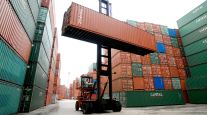Intermodal Shipments Climb as Container Imports Surge
This story appears in the Nov. 15 print edition of Transport Topics.
Intermodal shipments in the third quarter of 2010 erased recession-related volume losses, climbing 20% from a year ago as container shipments of imported goods surged, the Intermodal Association of North America reported.
International container shipments rose 28% to 2.01 million, and domestic intermodal set a quarterly record of 1.59 million shipments. Total shipments reached the third-highest total ever, 3.6 million, topping the third quarter of 2008, when economists say the recession began.
Intermodal freight has rebounded almost 30% since the first quarter of last year, when it hit a recessionary trough of 2.79 million shipments. That traffic was nearly 1 million below the record 3.70 million shipments moved in the third quarter of 2006.
“We have been very, very busy,” Zach England, vice president of intermodal for C.R. England Inc., Salt Lake City, told Transport Topics on Nov. 10.
England’s intermodal fleet of 320 trailers is “maxed out” and running at full capacity, he said, fueling the company’s optimism about truck/rail business as well as its plans to grow the fleet.
“We feel very strongly that so many signs point to the viability of intermodal,” England added, including environmental benefits, the driver shortage and the ability to provide what he called “tremendous value” to customers.
The international surge “suggests retailers are expecting strong volume sales (if not necessarily strong pricing) during the coming holiday season,” IANA said in its Market Trends & Statistics report.
Consumer spending also will be a key factor in determining 2011 industry performance, according to the Nov. 5 report.
Rail analyst Anthony Hatch spotlighted other factors that are driving growth of intermodal shipping right now.
“Shippers are looking at the intermodal product as a viable one and are migrating a higher percentage of freight to intermodal,” Hatch said. “They are starting to grow intermodal now rather than turn in desperation to an already full rail network [in 2011], when they can’t get a truck.”
Intermodal will be helped next year by expected tightness in trucking capacity caused by a driver shortage, hours-of-service rule changes, fuel price increases and potential driver disqualifications in the Federal Motor Carrier Safety Administration’s Compliance, Safety and Accountability program, Hatch said.
One sign of truckload carriers’ growing participation in intermodal was a 20% increase in third-quarter shipments made in 48-foot and 53-foot trailers that those fleets use, Tom Malloy, IANA’s vice president for member services and communications, told TT.
Some of that growth may relate to a shortage of domestic containers that forced some intermodal customers to use trailers instead of containers.
A resumption of domestic container fleet acquisitions in the second half of 2010 will increase intermodal capacity and also should help to buoy growth in that sector, IANA said in its report.
“We continue to push to get our [intermodal] volumes back up,” said Ike Brown, who heads NFI Industries’ intermodal unit. “It has been a squeeze between the rail price increases and what we can get from the shipper.”
In addition to rail rate increases of at least 10% to 15%, Brown said, NFI’s intermodal business has been hurt by the domestic container shortage, because its road/rail service for dry van freight is not asset-based.
One highlight has been the move by NFI, Vineland, N.J., to put 50 new 53-foot refrigerated containers into service, Brown said.
“We thought that was the biggest growth segment of the food business,” Brown told TT. “It is a niche that we felt wasn’t being exploited; it is growing much faster than the dry-food sector.”
“It’s all encouraging news if you are an intermodalist,” IANA’s Malloy said. “We are back in a more predictable cycle than we have seen in the past 24 months. The next quarter will look great because of the drop-off during the fourth quarter of last year.”
In that 2009 quarter, rail/truck shipments reached 3.06 million.
Comparing quarter to quarter, intermodal volume rose 9% from the 3.32 million loads handled in the second quarter of this year. During the quarter, August was the busiest month, with 1.22 million shipments, just ahead of the 1.2 million in September.
Some truckload segments also have shown solid growth, said Bob Costello, American Trucking Associations’ chief economist.
Describing the market for truckload shipments of more than 1,000 miles as “fabulous,” Costello said growth in that sector over the year-earlier period was 13% in August and 14.8% in September.




